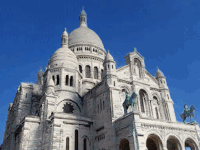| Synthesizing The Bigger Picture |
| Written by David Conrad | |||
| Sunday, 09 August 2020 | |||
|
There are more cameras in the world and more people taking photos all the time than ever before. What is more we all tend to take the same shots whenever we are near something "touristy". A new technique can put these crowdsourced photos together into a single image, capturing the many viewpoints. The title of this research from Noah Snavely and his team at Cornell Tech is "Crowdsampling the Plenoptic Function" and this isn't a title likely to pique the interest of the man in the street - "plenwhat?" The reality is much more interesting than it sounds and it illustrates how much the world we live in has changed. You talk about big data, but here it is - big data in the form of a crowdsourced photo that we all took. I can't put it better than the abstract: "Many popular tourist landmarks are captured in a multitude of online, public photos. These photos represent a sparse and unstructured sampling of the plenoptic function for a particular scene. In this paper, we present a new approach to novel view synthesis under time-varying illumination from such data." You can almost guess what they did next. They collected a big sample, aproximately 50K photos, from Flickr for a range of tourist sites. Next they identified the viewpoints (the red dots) for each photo:
Which only goes to prove that we really do all take the same picture - in future buy a postcard? Actually there is enough variablity in the space and time that the photos were taken to attempt a reconstruction of the plenoptic function. This is just the plot of the color of every point x,y as seen from position u,v at time t. If you have the plenoptic function, or more practically an approximation to it, you can create a view from any position at any time. The details are complicated, but what happens next is that a neural network learns how to extract plenoptic slices from the photos. From this you can do some interesting things. In particular you can show what the scene looks like from different viewpoints - smoothly moving from one to another. You can also arrange for a smooth change in what the scene looks like at different times. Watch the video to see it in action (and don't miss the bit at the start where the researchers wave at you):
If you visit the experiment's site you can see many examples of the the reconstruction of visual scenes from crowdsourced photos. I have to admit that while I am impressed and intrigued I can't think of a serious application. Artistic/creative perhaps, but not a really "must have" application. Perhaps I'm just not thinking of the right sort of things?
More InformationCrowdsampling the Plenoptic Function Zhengqi Li, Wenqi Xian, Abe Davis and Noah Snavely Cornell University Related ArticlesCrowd Sourced Solar Eclipse Megamovie Plenoptic Sensors For Computational Photography Light field camera - shoot first, focus later To be informed about new articles on I Programmer, sign up for our weekly newsletter, subscribe to the RSS feed and follow us on Twitter, Facebook or Linkedin.
Comments
or email your comment to: comments@i-programmer.info
|
|||
| Last Updated ( Sunday, 09 August 2020 ) |



